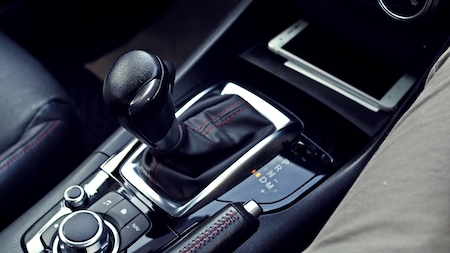Once upon a time, every car on the road operated with a manual transmission.
A manual transmission, or a standard transmission is a multi-speed vehicle where it requires the driver to manually perform the gear changes by operating a gear stick and a clutch.
Where manual transmissions were once the norm, as automation came into the industry, automation made the entire process easier for the driver. In 2020, only 41 out of the 327 – 13 percent – new car models sold in the US were manual transmission. Compare that to 2011 when 37 percent came with manual transmissions.
Manual transmission requires skill of the driver to create an effective driving environment. While diehards love the experience of being in control, many drivers, especially in urban areas, appreciate automation and not having to be as aware of the process as they are moving in and out of traffic.
With a manual transmission, they are usually cheaper to maintain than an automatic because they are far less complex in their innerworkings. Automatic transmissions have more parts, more technology built in, and more hydraulics and electronics to ensure the gear movement works smoothly as it’s supposed to.
 A manual transmission relies on you to operate the clutch and shift as needed.
A manual transmission relies on you to operate the clutch and shift as needed.
An automatic transmission relies on technology.
That gives the advantage to a manual transmission when comparing repair costs. Of course, there are other circumstances that impact longevity. Like everything in your vehicle, regular maintenance is everything.
Maintenance when driving a manual transmission
No matter what type of car you drive, regular maintenance is a part of your routine.
No matter what car you drive, it’s a good idea to refer to your owner’s manual to learn more about the maintenance process. The manufacturer created a guide to help you keep your car in good operating condition, making recommendations for repair work and replacement to add longevity.
While transmission fluid doesn’t need replacement as rapidly as motor oil, it’s still something that impacts the way your car moves and drives. Transmission fluid may need to be replaced every 15,000 miles or so – follow the guidelines for your make and model.
Scheduling transmission fluid changes will keep fresh transmission fluid in your vehicle, helping it run better. But don’t assume it stays fresh and without problems as you operate your vehicle. Transmission fluid can be checked similarly to motor oil. You’ll find a dipstick under the hood to perform periodic checks. Be sure levels remain constant, and look for any discoloration, which could mean there’s a leak and a seal needs replacing.
Be conscious of how you move through the gears. Be sure the clutch is all the way in before you move between gears. To prevent wear and tear, be sure you come to a complete stop before moving to reverse. If something feels like it’s sticking, don’t force the gears.
Maintenance when driving an automatic transmission
In many ways, properly maintaining an automatic transmission is similar to a manual.
Check the transmission fluid periodically to ensure it’s filled. If you notice it’s low, or a change in color has occurred, it’s time to bring it in for a mechanic to evaluate the system. Transmission fluid is naturally a clear, bright red color with a slightly sweet smell. If you notice the fluid is dark, murky, or loses its sweet smell, it’s time for replacement.
Don’t just throw any transmission fluid into your vehicle; every make and model comes with specific recommendations. This is also where it’s nice to have a trusted service station on your side, one you can trust to provide you with high quality fluids and parts.
Depending on your vehicle, you might also need occasional transmission fluid flush. This ensures fresh fluid stays within your vehicle, while older fluid is flushed from the system, no longer impacting your car.
While you might not have as much control over when the gears move as you’re driving, you should still pay attention to the shifting process. Never throw your vehicle into park while your car is still rolling to a stop. Never move to reverse unless your vehicle is at a complete stop.
When you drive down steep grades, you should also move the gears manually into a lower gear to help control your speed without relying on the braking system. Too much heat from constant pressure on the brake pads can cause the system to overheat, putting you and your vehicle at greater risk.
Where costs change
Whether you have a manual transmission or automatic, maintenance starts with transmission fluid. Over time, you may have to replace various parts, depending on your vehicle and the driving conditions.
How new is your vehicle? Some transmission parts may be covered by the manufacturer’s powertrain warranty. Depending on your vehicle, this might last 60,000, 80,000 miles, or more.
The clutch, however, for a manual transmission will not be a part of that warranty. It is considered a “wear” item, and will only fall under more generic warranty coverage, possibly with 12,000 miles or so of coverage.
If you drive your manual hard, you might go through clutches rapidly. This means more maintenance than you would experience with an automatic vehicle that handles shifting for you.
Automatic transmissions can also be abused. Hard drivers are always more susceptible to wear issues than drivers that learn to take things slow. Avoid quick stops and throwing your vehicle into gear. Never force movement when it’s not there. And pay attention to changes in the way your vehicle moves. Any sound, any smell, any difference could be a sign of failure. The sooner you bring it in for evaluation, the quicker the repair can be made, potentially saving you money in the process.
How can we help you keep your manual or automatic transmission in good working condition?
